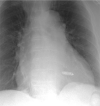A case series of the twiddler syndrome
- PMID: 38239312
- PMCID: PMC10794872
- DOI: 10.1093/ehjcr/ytae004
A case series of the twiddler syndrome
Abstract
Background: Twiddler syndrome (TS) is a complication of cardiac implantable electronic device (CIED) implantation, caused by the deliberate or unconscious manipulation of the device by the patient himself, which results in dislocation of the leads by retraction towards the subcutaneous pocket.
Case summary: This report describes two clinical cases that occurred in our centre, for which two different solutions were successfully implemented. In the first case, a complete removal of the stimulation system was performed, and a leadless pacemaker (PM; Medtronic Micra VR) was implanted. In the second case, the patient underwent a revision procedure. The PM was disconnected, and the electrodes were debrided, a submuscular pocket for the PM was created, and at the end of the procedure, the PM was anchored to the pectoralis major.
Discussion: Twiddler syndrome is a not so rare and serious complication of CIED implantation, leading to device malfunctioning and higher risk of infection of the pocket due to multiple re-interventions. In these two cases, different surgical solutions were performed, both resulting to be effective to solve the effects of TS.
Keywords: Case series; Leadless pacemaker; Submuscular pacemaker implant; Twiddler syndrome.
© The Author(s) 2024. Published by Oxford University Press on behalf of the European Society of Cardiology.
Conflict of interest statement
Conflict of interest: None declared.
Figures









References
-
- Liang JJ, Fenstad ER. Twiddler’s syndrome. Lancet 2013;382:e47. - PubMed
-
- Hossain S, Nasrullah Khan K, Parvez S. Twiddler’s syndrome—an uncommon, cause of pacemaker malfunction in elderly. Insight 2021;4:96–99.
Publication types
LinkOut - more resources
Full Text Sources
